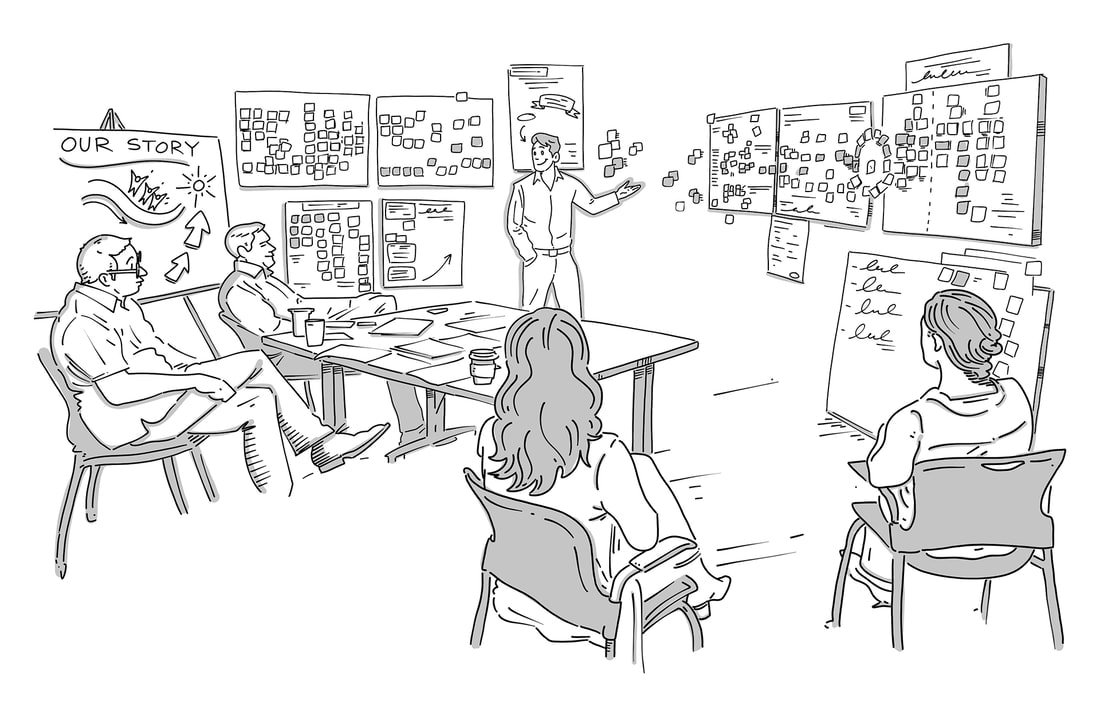|
From updating your strategy to scaling your team, growth is change and change is hard.
Visual Consulting (sometimes called Process Consulting)* is when a consultant is hired to visually “facilitate the organization to perceive, understand, and develop the organization’s business and human processes, in order for the client to improve the situation themselves, as they define it.” This differs from “Expert Consulting,” where the client has a perceived and predetermined need and a consultant is brought in to share their expertise related to that specific need. It is also different from “Pair-of-Hands Consulting” (or staff augmentation) where the consultant (or consulting team) is brought in to fulfill work that the client lacks the time or resources to deliver. Visual Consulting is about teaching the client to fish, not fishing for them, or selling them fancy fishing equipment. If you are experiencing the following, you may need someone to consult with on your vision, culture, story or strategy.
There are four things to look for when hiring a process consultant. 1. They are Process-Agnostic If a consultant tells you they have an out-of-the-box solution, don’t believe them. There is no one-size-fits-all remedy. There is no killer app in consulting. It is dynamic, empathy-based work that requires deep listening and should include the wisdom (and the elements that work) from different maps, models and methods. A good consultant should have a belief in human potential and a passion for building capacity on your team, regardless of what book they’re reading. 2. They Understand the Process of Change Look for a consultant that understands the positive and negative effects of change, what resistance to change looks like in individuals and groups, how to ease or work through that resistance, and ultimately, how to empower teams to lead themselves through change. If the change work (or creativity, or innovation) ends when the consultant leaves the room, they are not the right consultant for you. A good consultant strives to develop resilient, emotionally intelligent teams that are well-versed in the language of change and fire-tested in the crucible of transformation. 3. How They Do Anything is How They Do Everything Take notes on the sales/discovery call and their approach to setting boundaries and expectations. Notice the way they organize information and their attention to detail. This is exactly how they will engage with you (and possibly your clients). If they are late, rushing, scattered, forgetting things, their tone is too negative (or jarringly upbeat and positive) this is not a good sign. A good consultant matches your energy, makes you feel at ease, asks great questions, and sometimes provides clarity and answers before you can form the questions. 4. The Proof is in the Artifact They are a visual consultant, so look at their visuals. Are the final deliverables something that will be ready to share or distribute with your team/organization? Do they have visual impact? Will they be memorable or just another “dumb” report? The efforts and summary of your work should not only live on and easily shake hands with your implementation lead or strategic plan, but they should inform (or change) the way you tell your story -- internally and externally. If you still have questions, let’s set up a Discovery Call to discuss what’s happening in your business. * Source: Visual Consulting: Designing and Leading Change, David Sibbet and Gisela Wendling, PhD.
0 Comments
Your comment will be posted after it is approved.
Leave a Reply. |
Details
ABOUT THE AuthorJoran Slane Oppelt is an international speaker, author and consultant with certifications in coaching, storytelling, design thinking and virtual facilitation. Archives
March 2024
Categories
All
|


 RSS Feed
RSS Feed